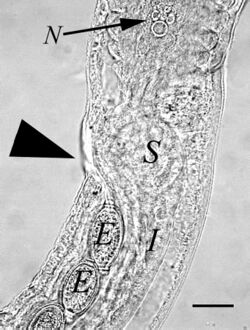Biology:Stichocyte
From HandWiki
Short description: Human Cellular Biology

Stichocyte at the posterior extremity of the oesophagus in Capillaria aerophila. N: nucleus of the posteriormost stichocyte. Bar = 50 µm
Stichocytes are glandular unicellular cells arranged in a row along the posterior portion of the oesophagus, each of which communicates by a single pore with the lumen of the oesophagus. They contain mitochondria, rough endoplasmic reticulum, abundant Golgi apparatuses, and usually 1 of 2 types of secretory granules, α-granules and β-granules, indicating secretory function.[1][2][3][4][5][6][7][8] Collectively stichocytes form the stichosome. Characteristic of Trichocephalida and Mermithida,[1] two groups of nematodes.
References
- ↑ 1.0 1.1 Chitwood, B. G. & Chitwood, M. B. (1950). Introduction to Nematology (Vol. 1). Baltimore: Monumental Printing Co.doi:10.5962/bhl.title.7355
- ↑ Peter J. Gosling. Dictionary of Parasitology. 2005
- ↑ Heinz Mehlhorn. Encyclopedia of Parasitology. 3rd Edition 2008
- ↑ Larry Roberts, John Janovy. Foundations of Parasitology. 8th edition 2008
- ↑ Michael Hutchins, Donna Olendorf. Grzimek's Animal Life Encyclopedia: Lower metazoans and lesser deuterosomes. 2004
- ↑ HG Sheffield. Electron microscopy of the bacillary band and stichosome of Trichuris muris and T. vulpis. Journal of Parasitology, 1963
- ↑ Despommier, DD; Müller, M (Oct 1976). "The stichosome and its secretion granules in the mature muscle larva of Trichinella spiralis". Journal of Parasitology 62 (5): 775–85. doi:10.2307/3278960. PMID 978367.
- ↑ Lalošević, V.; Lalošević, D.; Capo, I.; Simin, V.; Galfi, A.; Traversa, D. (2013). "High infection rate of zoonotic Eucoleus aerophilus infection in foxes from Serbia.". Parasite 20: 3. doi:10.1051/parasite/2012003. PMID 23340229.
 |

